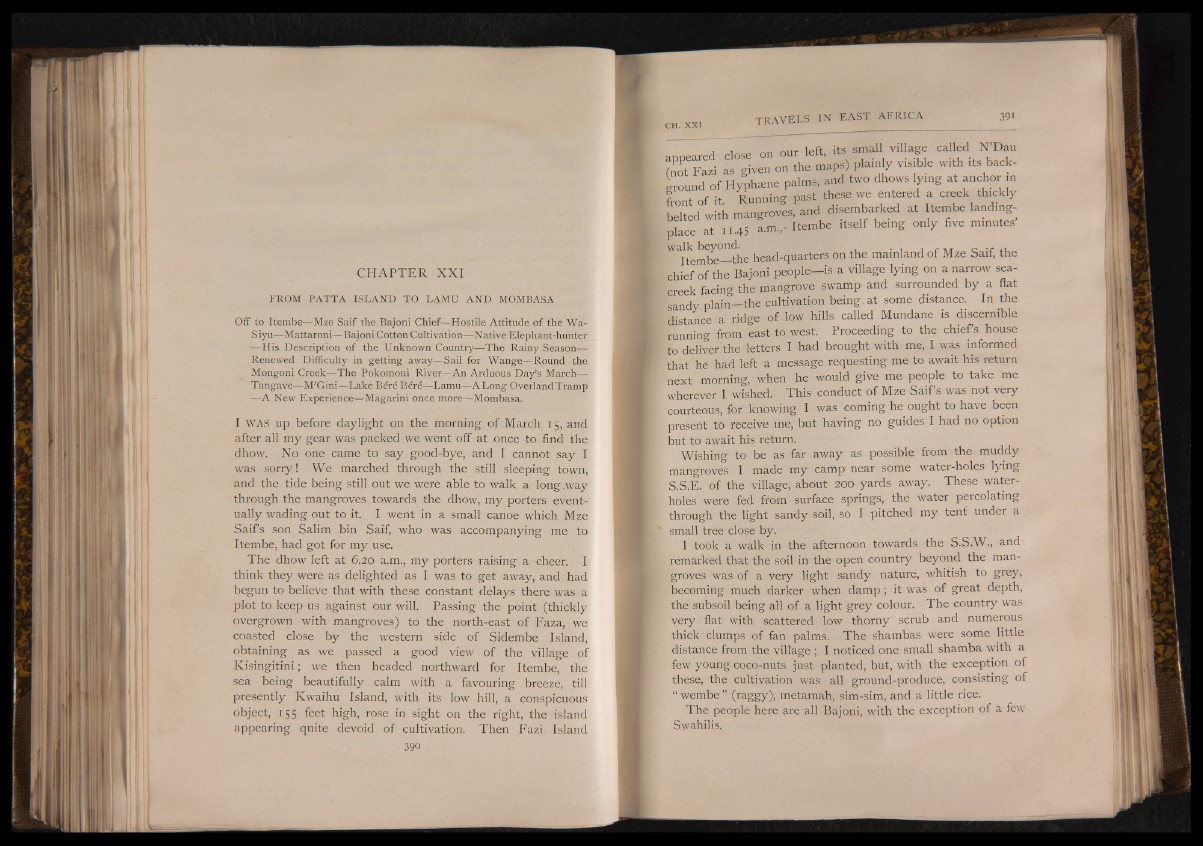
CH AP TER XXI
FROM PATTA ISLAND TO LAMU AND MOMBASA
Off to Itembe— Mze Saif the Bajoni Chief—Hostile Attitude of the Wa-
Siyu— Mattaroni— Bajoni Cotton Cultivation— Native Elephant-hunter
— His Description of the Unknown Country— The Rainy Season—-
Renewed Difficulty in getting away— Sail for Wange— Round the
Mongoni Creek— The Pokomoni River— An Arduous Day’s March - -
Tangave— M’Gini—Lake Bdrd Bdrd-—Lamu4^ALong QverlandTramp
- jLAA New Experience— Magarini once more— Mombasa.
I WAS up before daylight on the morning of March 15, and
after all my gear was packed we went off at once to find the
dhow. No one came to say good-bye, and I cannot say I
was sorry! We marched through the still sleeping town,
and the tide being still out we were able to walk a long way
through the mangroves towards the dhow, my porters eventually
wading out to it. I went in a small canoe which Mze
Saifs son Salim bin Saif, who was accompanying me to
Itembe, had got for my use.
The dhow left at 6.20 a.m., my porters raising a -cheer. I
think they were as delighted as I was to get away, and had
begun to believe that with these constant delays there was a
plot to keep us against our will. Passing the point (thickly
overgrown with mangroves) to the north-east of Faza, we
coasted close by the western side of Sidembe Island,
obtaining as we passed a good view of the village of
Kisingitini; we then headed northward for Itembe, the
sea being beautifully calm with a favouring breeze, till
presently Kwaihu Island, with its low hill, a conspicuous
object, 155 feet high, rose in sight on the right, the island
appearing quite devoid of cultivation. Then Fazi Island
nnneared close on our left, its small village called N’Dau
fiot Fazi as given on the maps) plainly visible with its background
of Hyphaene palms, and two dhows lying at anchor in
front of it. Running past these we entered a creek thickly
belted with mangroves, and disembarked at Itembe landingplace
at I I .45 B p Itembe itself bemg ° nly fivC mmUteS
Waitembe— the head-quarters on the mainland of Mze Saif, the
chief of the Bajoni people— is a village lying on a narrow sea-
creek facing the mangrove swamp and surrounded by a flat
sandy plain—the cultivation being, at some distance. In the
distance a ridge of low hills called Mundane is discernible
running from east to west. Proceeding to the chiefs house
to deliver the letters I had brought with me, I was informed
that he had left a message requesting me to await his return
next morning, when he would give me people to take 'me
wherever I wished. This conduct of Mze Saifs was not very
courteous, for knowing I was coming he ought to have been
present to receive me, but having no guides I had no option
but to avSrait his. return.
Wishing to be as far away as possible from the muddy
mangroves I made my camp' near some water-holes- lying
S.S.E. of the village, about 200 yards away. These water-
holes were fed from surface springs, thé water percolating
through the light sandy soil, so I pitched my tent under a
, small tree close by.
I took a walk in the afternoon towards the S.S.W., and
remarked that the soil in the open country beyond the mangroves
was of a yery light sandy nature, whitish to grey,
becoming much darker when damp ; it was of great depth,
the subsoil being all of a light grey colour. The country was
very flat with scattered low thorny scrub and numerous
thick clumps of fan palms. The shambas were some little
distance from the village ; I noticed one small shamba with a
few young coco-nuts just planted, but, with the exception of
these, the cultivation was all ground-produce, consisting of
I wembe ” (raggy), metamah, sim-sim, and a little rice.
The people here are all Bajoni, with the exception of a few
Swahilis,